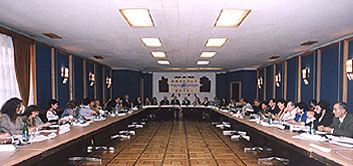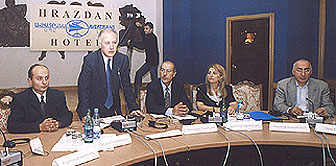- The
Armenian Center for National and International Studies (ACNIS) convened
a specialized policy seminar here today on “The Educational and Cultural
Guaranties for the Self-Preservation of National Minorities.” The conference
was held within the framework of the Council of Europe project on “Coordination
among National Minorities and Information Exchanges on Minority Rights
in Armenia.” .
The seminar brought together the representatives of all national minority
communities in Armenia to focus on the most pressing problems in the
spheres of education and culture.
- Hrach Hakobian of ACNIS addressed the capacity
audience with opening remarks. “The authorities should think of the
people but the people, the citizens should never allow the authorities
to think for them. I suggest we have practical discussions to formulate
the challenges of the national minority communities today, to find adequate
solutions to their imperatives.”
- Olga Baghdasarian, principal of the Verin Dvin
village school in the Ararat region, presented the concerns of the Assyrian
community at the levels of preliminary and secondary education. According
to Ms. Baghdassarian, the Assyrian language has been taught at schools
since 1972 in the absence of textbooks, although over the last six years
the students have had some books made available to them by the Assyrian
Association. Ms. Baghdassarian called on the Ministry of Education and
Science of Armenia to provide textbooks for the Assyrian students. Another
problem of the community is lack of qualified teachers to teach the
Assyrian language.
- Knyaz Hasanov, representative of the Kurdish
community in Armenia, presented the Kurdish aspect. He stated that the
previous achievements of the Kurds in Armenia are under threat. For
lack of finances, the Kurdish newspaper that had been published over
the past seventy years has been shut down. In his opinion, the Armenian
government should provide national minorities with financial resources
to have such newspapers published.
- Misha Muradian, secondary school principal of
Amre Taza village, pointed out the issues faced by the Yezidi community
which included such problems as lack of windowpanes, textbooks, and
more importantly a water supply system.
- Slava Rafaelidis, chairman of the Council of
Armenian Nationalities who also represents the Greek community, added
that “it would be advantageous to have representatives of national minorities
on the staffs of the Armenian ministries. It would ease the process
of finding solutions to community problems.”
- Rabbi Gersh Bourstein, head of the Mordekhay
Navi Jewish Community of Armenia, in discussing his community’s difficulties,
was concerned about the current process of optimization of schools,
which according to him, put the benefit of having or not having a few
national schools under threat.
- Armenouhi Hovannisian, executive director of
Junior Achievement of Armenia, stated in her speech that the new textbook
on civic education, which has been prepared by her organization for
compulsory use by 9th grade students, encompasses information about
the national minorities of Armenia and aims first and foremost to create
an atmosphere of tolerance towards them. It also encourages the children
of national minorities to integrate into mainstream society and to feel
proud of their national identity.
- With respect to problems dealing with their
cultures, nearly all representatives of the national minorities stressed
the priority of establishing the common cultural center promised but
not realized by the president of Armenia.
- The formal deliberations were followed by questions,
answers, and a lively exchange among
. Siaband Bakoyan, Chairman of “Ezdikhana” public political Organization’s
Political Council;
. Alikhan Shababian, representative of Nor Nork district council;
. Rostom Aloyan, Principal of Alagiaz village school;
. William Weiner, Director of “Menora” Jewish Community’s Cultural Center;
. Rima Varzhapetian, Chairwoman of the Jewish Community of Armenia;
. Razmik Khosroev of the Assyrian community;
. Arsen Mikhailov, Chairman of Atur Assyrian Union;
. Taisa Arsentevna, Principal of Dimitrov village school, Ararat Region;
. Irina Gasparian, representative of Assyrian Community;
. Yuri Yakovenko, Chairman of “Rossia” NGO, Principal of Slavic secondary
school;
. Alexander Yaskorski, head of the German community;
. Julietta Weis of German Community, Sunday school teacher;
. Olha Parkhomenko, head of the “Association of Ukrainians;”
. Romania Yavir, Chairwoman of the Ukrainian Community in Armenia;
. Valentina Krishtopik, Chairwoman of Belarus Community in Armenia;
. Alla Kuzminskaya Chairwoman of the Polish Community in Armenia;
. Karapet Kalenchian of ACNIS;
. Stepan Safarian Project Director;
. Hranush Kharatian, Head of the Center for Ethnographical Research;
. Nara Gulian, Assistant to the Presidential Advisor;
. Avetik Ishkhanian of the Armenian Helsinki Committee;
. Shavarsh Khachatrian, researcher at UK
New Castle University;
. Ara Sahakian of the “Armat” center;
. Ovsanna Madatian, editor of Lalish Yezidi monthly newspaper;
. Garnik Guyumjian of the Ministry of Culture, Sport and Youth Issues;
. Nadia Antonian of the Ministry of Education and Science;
. and many others.
|

